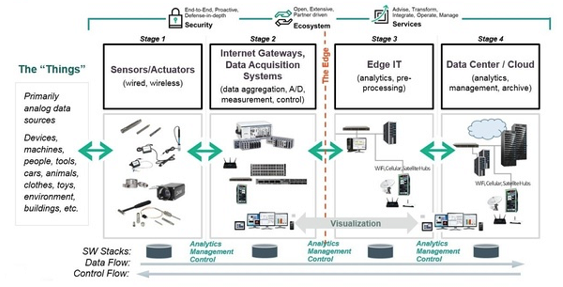Internet of Things (IoT)
This tutorial gives an introduction to “Internet of Things” or IoT. It is basically a network of physical objects or people called “things” that are embedded with software, electronics, network, and sensors which allows these objects to collect and exchange data.
The Internet of Things is a very useful concept, it means taking all the things in the world and connecting them to the internet. And when something is connected to the internet, that means that it can send information or receive information, or both. This ability to send and/or receive information makes things smart.
The main objective of IoT is to extend to internet connectivity from standard devices like computer, mobile, tablet to relatively dumb devices like a toaster. IoT makes virtually everything “smart,” by improving aspects of our life with the power of data collection, artificial intelligence (AI) based algorithms, and networks.
IoT Architecture
IoT is the technology that builds systems capable of autonomously sensing and responding to stimuli from the real world without human intervention. We therefore need to develop a process flow for a definite framework over which an IoT solution is built. The IoT framework architecture generally comprises of these 4 stages. Figure 1 below shows the 4-stage architecture of IoT framework.

Figure 1: The 4-stage architecture of IoT framework
Stage 1 (Sensors / Actuators):
The first layer is the physical layer that is comprised of sensors that can sense and collect data from the environment. Its work includes the pick up of physical parameters or identifying other smart objects. Then, we come to the actuators that can affect a change in the environment. For example, a sensor will sense that the temperatures have changed and the light is low, and thus, at is dusk, an actuator will then automatically switch on the street lights.
Stage 2 (Internet Gateways / Data Acquisition Systems):
Then comes the Internet Gateway Layer. The data that comes from the sensors needs to be prepped before it enters the eventual processing stage. Basically, the data that is received in the analog form needs to be aggregated and converted to digital form, and this layer does exactly that with the help of an Internet gateway that routes it over WLANs or other networks for further processing. Both of the above layers are situated closely with each other so that collection pre-processing can be done in real time. These gateways can be built with additional functionalities like analytics, protection against malware, and data management.
Stage 3 (Edge IT / Analytics):
The pre-processed data then enters the Edge Computing IT systems to perform further analysis of the data. While the above two layers will be located at an actual site of the device, an edge IT processing system will be situated in remote offices or other edge locations but not as far as the DC. Usually, the IoT data is so enormous that, if directly sent to the data center or server, it can eat up crazy amounts of network bandwidth, swamping your resources. Thus, systems at the edge perform analytics to lessen the burden on core IT infrastructure.
Stage 4 (Data Center / Cloud Analytics):
The last stage is where data is analyzed, managed, and stored on strong IT systems. This data is the one that needs more processing, and the feedback need not be immediate. A data center or a cloud-based system suits this purpose perfectly. Here, the results take some time, but what is available is more in-depth and can be combined with other data for deeper insights.
The first two parts of the architecture or the first two stages are all about Operations Technology (OT), while the next two are about Information Technology (IT). While the two are not mutually exclusive, the lines are definitely blurring. A higher level of collaboration is required between the two as the functions start to converge to execute more value for IoT via data processing and domain expertise.
The above architecture can also be defined in layers like:
The perception layer (stage 1), which is essentially the physical layer of sensors/actuators.
The transport or network layer (stage 2), which connects the ‘smart things’ to network devices and servers or basically transfers the sensor data from perception to the processing layer through networks.
The processing layer (stage 3) stores, analyzes, and processes the humongous data and employs various technologies, like big data, etc.
The application layer (stage 4), which delivers application-specific services to the user.
Besides, a cloud-based systems architecture can also deploy a fog-based architecture. In the former, data processing is done in a largely centralized fashion by cloud computers where the cloud is at the center of the system with applications above and the network of smart things below it. This type of a system provides excellent flexibility and scalability, like core infrastructure, platform, software, and storage. In fog computing, the architecture comprises of monitoring, preprocessing, storage, and security layers between the physical and transport layers.